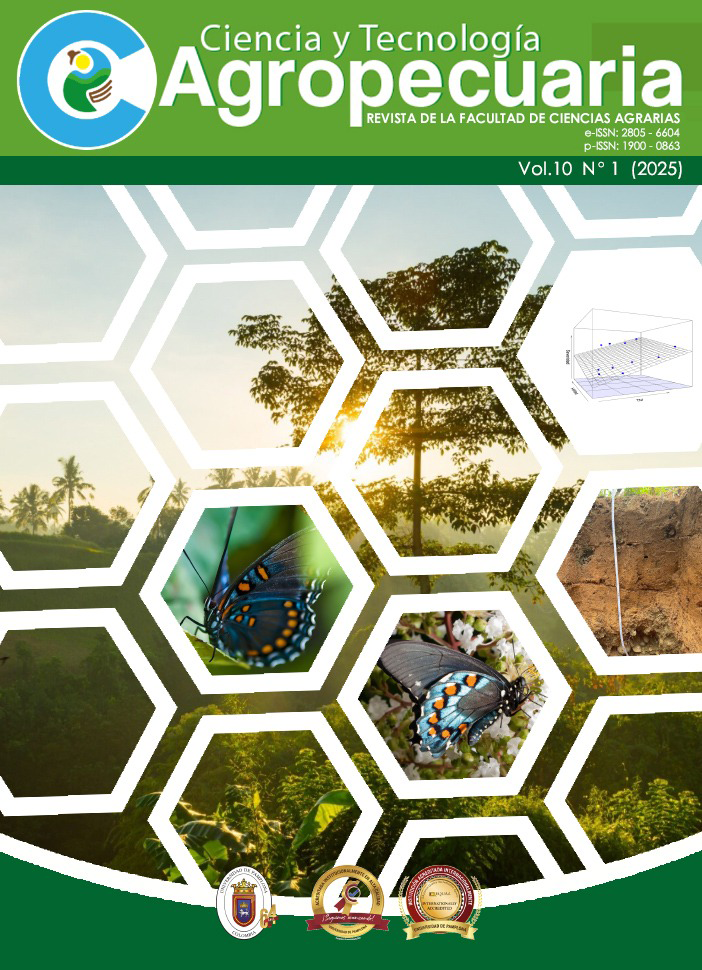Characterization of the marketing of meat in Barranquilla-Colombia through multivariate analysis
DOI:
https://doi.org/10.24054/cyta.v10i1.3768Keywords:
meat marketing, sanitary conditions, innocuousness, food quality, multiple correspondence analysisAbstract
This research addresses the problem of sanitary conditions affecting the innocuousness of meats distributed and marketed in Barranquilla. descriptive observational study sought to characterize the marketing of meat in Barranquilla through multivariate analyses; methodology was to assign data collection routes, based on information obtained from the population (meat traders who enter Barranquilla from different ports in the department of Atlantico) through questionary, subjected to the number of units obtained in sampling. Results indicated that most traders do not meet minimum health requirements, nor do they have food conservation and refrigeration infrastructure or equipment; therefore, proper cooling conditions need to be ensured during transport and distribution to their final destination. In addition, health training should be promoted to food handlers, in order to ensure the safety and quality of food.
Downloads
References
Aguirre, A., Baquero, A., Gómez-Cáceres, L., & Torregroza, A. (2016). Condiciones higiénico-sanitarias de los expendios comercializadores de carne de res en la ciudad de Sincelejo, Colombia. Ingeniería, Innovación y Desarrollo Sostenible, 51–66.
Barreto-Rodríguez, G. E., Herrera-Acosta, R. J., & Morales-Pinto, N. G. (2020). Análisis multidimensional en la comercialización de las carnes y queso costeño que ingresan al departamento del Atlántico (1ª ed.). Editorial Universidad del Atlántico.
Carrillo, M., & Reyes, A. (2013). Vida útil de los alimentos. Revista Iberoamericana de las Ciencias Biológicas y Agropecuarias, 2(3), 32–56.
Carron, M., Chang, Y. M., et al. (2018). Campylobacter, a zoonotic pathogen of global importance: Prevalence and risk factors in the fast-evolving chicken meat system of Nairobi, Kenya. PLOS Neglected Tropical Diseases, 12(8), e0006658. https://doi.org/10.1371/journal.pntd.0006658
da Vitória, A. G., Oliveira, J. S. C., et al. (2021). Food safety knowledge, attitudes and practices of food handlers: A cross-sectional study in school kitchens in Espírito Santo, Brazil. BMC Public Health, 21, 349. https://doi.org/10.1186/s12889-021-10282-1
Dorado, E. (2013). UF0352: Acondicionamiento de la carne para su comercialización. Certificado de Profesionalidad INAI0108 – Carnicería y elaboración de productos cárnicos. IC Editorial.
Eltholth, M., Fornace, K., et al. (2015). Characterization of production, marketing and consumption patterns of farmed tilapia in the Nile Delta of Egypt. Food Policy, 51, 131–143. https://doi.org/10.1016/j.foodpol.2015.01.002
Finger, J. A., Baroni, W. S., et al. (2019). Overview of foodborne disease outbreaks in Brazil from 2000 to 2018. Foods, 8(10), 434. https://doi.org/10.3390/foods8100434
Hathaway, S. C. (2013). Food control from farm to fork: Implementing the standards of Codex and the OIE. Revue Scientifique et Technique, 32, 479–485. https://doi.org/10.20506/rst.32.2.2247
Hocquette, J. F., Botreau, R., et al. (2012). Opportunities for predicting and manipulating beef quality. Meat Science, 92(3), 197–209. https://doi.org/10.1016/j.meatsci.2012.04.007
Hung, Y., de Kok, T. M., & Verbeke, W. (2016). Consumer attitude and purchase intention towards processed meat products with natural compounds and a reduced level of nitrite. Meat Science, 121, 119–126. https://doi.org/10.1016/j.meatsci.2016.06.002
Kristinsson, K. G., & Georgsson, F. (2015). Infection risks associated with importation of fresh food in Iceland. Laeknabladid, 101(6), 313–319. https://doi.org/10.17992/lbl.2015.06.32
Ministerio de la Protección Social. (2004, agosto 20). Resolución 2652: Por la cual se establece el reglamento técnico sobre los requisitos de rotulado o etiquetado que deben cumplir los alimentos envasados y materias primas de alimentos para consumo humano. https://www.minsalud.gov.co/Normatividad_Nuevo/RESOLUCI%C3%93N%202652%20DE%202004.pdf
Ministerio de la Protección Social. (2007, mayo 4). Decreto número 1500: Por el cual se establece el reglamento técnico a través del cual se crea el Sistema Oficial de Inspección, Vigilancia y Control de la Carne, Productos Cárnicos Comestibles y Derivados Cárnicos destinados para el consumo humano... http://www.minambiente.gov.co/images/normativa/decretos/2007/dec_1500_2007.pdf
Ministerio de Salud y Protección Social. (2013, julio 25). Resolución 2674: Por la cual se reglamenta el artículo 126 del Decreto-ley 019 de 2012 y se dictan otras disposiciones (Diario oficial No. 48862). https://www.invima.gov.co/normatividad/normatividad-interna/resoluciones-normatividad/resolucion-2674-2013-pdf/download.html
Ministerio de Salud y Protección Social. (1993, febrero 12). Resolución 604: Por la cual se reglamenta parcialmente el título V de la Ley 9ª de 1979, en cuanto a las condiciones sanitarias de las ventas de alimentos en la vía pública.
Ministerio de Transporte. (2004, septiembre 6). Resolución 2505: Por la cual se reglamentan las condiciones que deben cumplir los vehículos para transportar carne, pescado o alimentos fácilmente corruptibles. https://paginaweb.invima.gov.co/images/stories/resoluciones/RESOLUCION_No._002505_DE_2004.pdf
Paredes-Torres, O. R., García-Ruiz, L., et al. (2021). Factores de riesgo asociados con morbilidad y mortalidad postoperatoria en gastrectomía radical D2 por cáncer gástrico. Revista de Gastroenterología de México. https://doi.org/10.1016/j.rgmx.2020.11.004
Peñarubia, O., Ward, A., Grever, M., & Ryder, J. (2020). Addressing food loss and waste in fish value chain using a web-based information repository. IOP Conference Series: Earth and Environmental Science, 414(1), 012016. https://doi.org/10.1088/1755-1315/414/1/012016
Pulido-Medina, C., & Mejía, C. R. (2018). Publicación científica de los docentes de medicina en una universidad colombiana: Características y factores asociados. Educación Médica Superior, 32(2).
Rustiawan, A., & Suryani, D. (2021). Intention on food safety among food handlers at the beach culinary tourism area. International Journal of Public Health Science, 10(2), 318–323. https://doi.org/10.11591/ijphs.v10i2.20859
Saeed, B. Q., Osaili, T. M., & Taha, S. (2021). Foodborne diseases risk factors associated with food safety knowledge and practices of women in Sharjah-United Arab Emirate. Food Control, 125, 108024. https://doi.org/10.1016/j.foodcont.2021.108024
Saldarriaga, J., Vélez-Zapata, C., & Betancur, G. (2016). Estrategias de mercadeo de los vendedores ambulantes. Semestre Económico, 19(39), 155–172. https://doi.org/10.22395/seec.v19n39a7
Sebastián Sebastián, C., García Mur, C., et al. (2020). Análisis de los factores radiopatológicos del cáncer de mama triple negativo y determinación de perfiles de riesgo. Radiología, 62(5), 365–375. https://doi.org/10.1016/j.rx.2020.01.001
Sirichokchatchawan, W., Taneepanichskul, N., & Prapasarakul, N. (2021). Predictors of knowledge, attitudes, and practices towards food safety among food handlers in Bangkok, Thailand. Food Control, 126, 108020.
Downloads
Published
How to Cite
Issue
Section
License
Copyright (c) 2025 Nuris Morales Pinto, Lourdes Isabel Meriño Stand, Roberto Herrera Acosta, Eliecer Rafael Preciado Morales, Genisberto Barreto Rodríguez

This work is licensed under a Creative Commons Attribution-NonCommercial-ShareAlike 4.0 International License.










